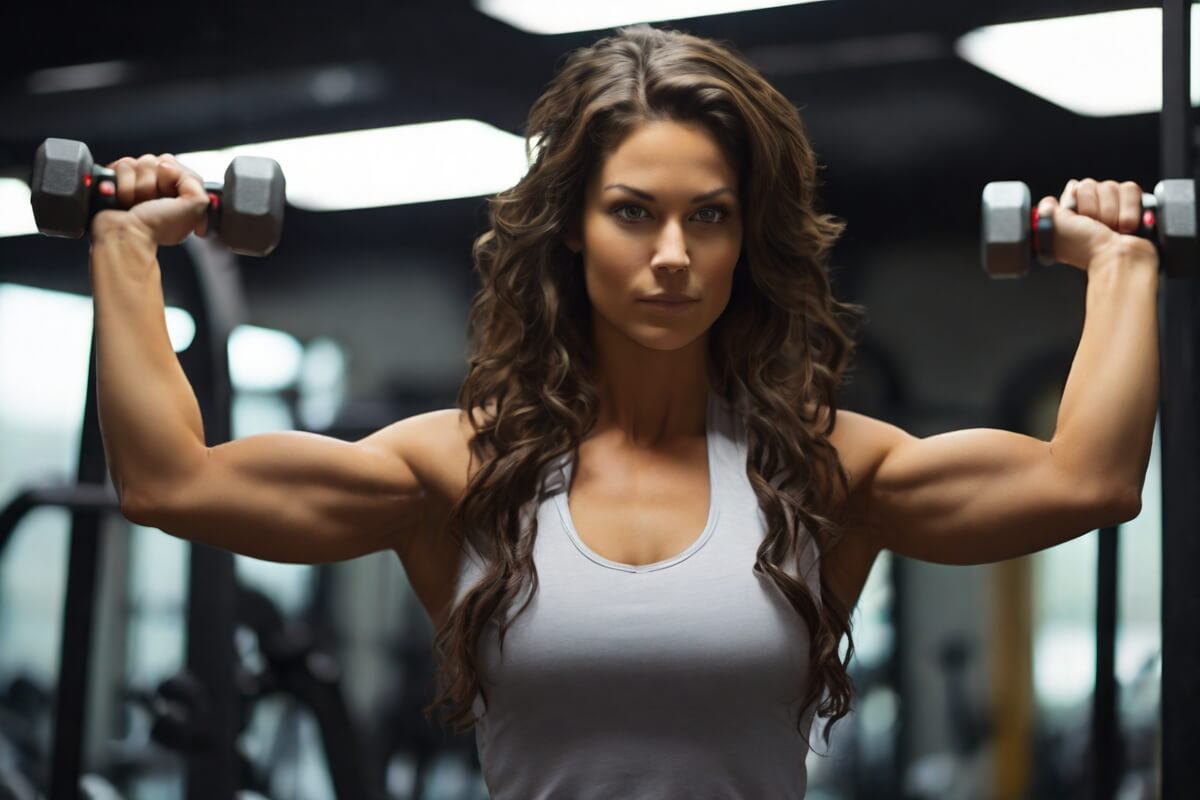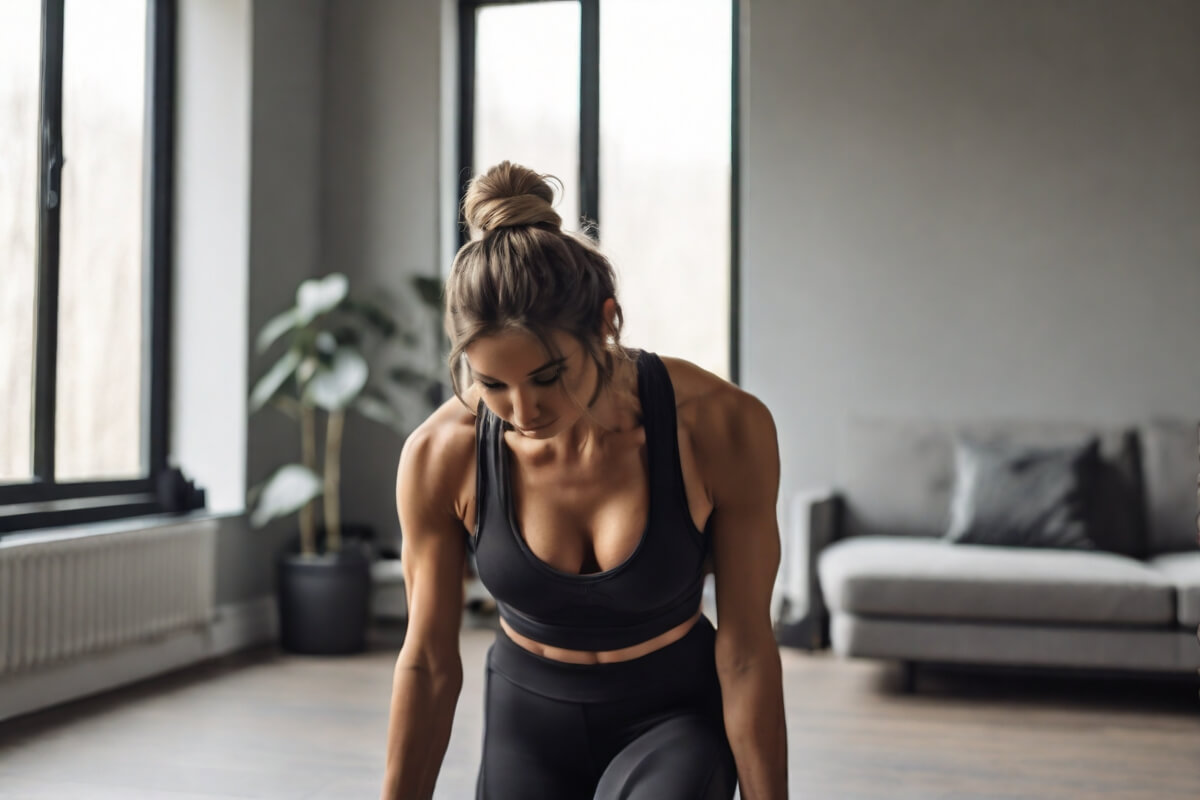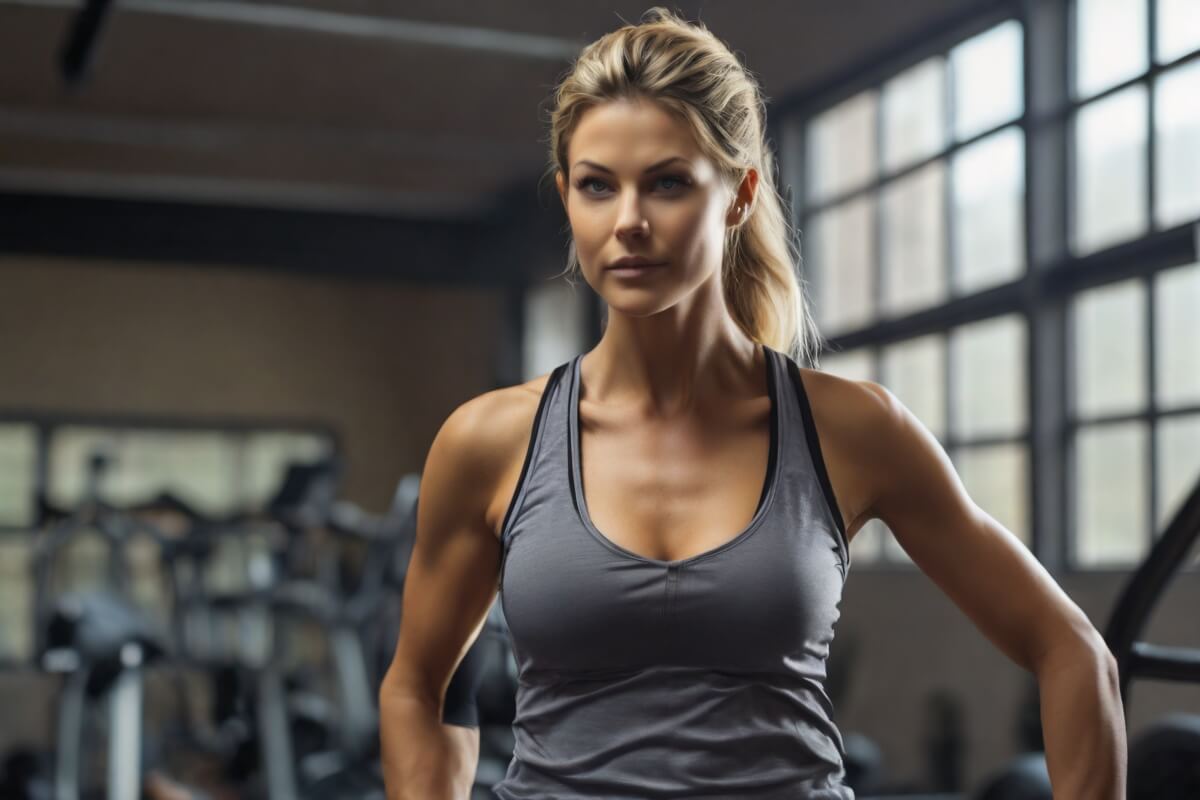Do you want to have stronger, leaner, and more defined arms? Do you want to improve your upper body strength, endurance, and functionality? Do you want to prevent injuries, reduce pain, and enhance your performance in sports and daily activities? If you answered yes to any of these questions, then this article is for you.
In this article, you will learn about 10 arm workouts that you can do at home. These workouts are suitable for all levels, as they can be modified according to your fitness level and goals. You will also learn how to do each workout correctly, what benefits they offer, and how to incorporate them into your routine.
Want To Get Ripped At Home? This Simple Home Workout Plan Has a 95.4% Success Rate Of Achieving Your Dream Physique! Click Here And See Now
Why You Should Work Out Your Arms

Before we dive into the workouts, let’s talk about why you should work out your arms in the first place. Here are some of the benefits of having strong arms:
- You burn more calories and fat. Your arms are one of the most active and visible parts of your body. They require more energy to move and maintain than other muscles. This means that when you work out your arms, you burn more calories and fat, both during and after the exercise. This can help you lose weight, improve your body composition, and boost your metabolism.
- You improve your overall health and fitness. Working out your arms can improve your cardiovascular health, as it increases your heart rate and blood flow. It can also improve your respiratory health, as it enhances your oxygen intake and delivery. It can also improve your hormonal health, as it stimulates the production of growth hormone and testosterone, which are essential for muscle growth, recovery, and repair. Working out your arms can also improve your bone health, as it strengthens your bones and prevents osteoporosis. It can also improve your immune health, as it reduces inflammation and fights infections.
- You enhance your performance and functionality. Working out your arms can improve your strength, power, speed, agility, and endurance. This can help you perform better in sports and physical activities, such as throwing, punching, lifting, and climbing. It can also help you function better in daily activities, such as carrying, pushing, pulling, and reaching. Working out your arms can also improve your balance, stability, and mobility, as it strengthens your core and stabilizes your joints. This can help you prevent falls, injuries, and pain, and improve your posture and alignment.
How to Work Out Your Arms at Home

Now that you know why you should work out your arms, let’s see how you can do it at home. You don’t need any fancy equipment or a gym membership to do these workouts. All you need is some space, a mat, a chair, and optionally, some weights, such as dumbbells, kettlebells, or water bottles.
Here are 10 workouts that you can do at home to strengthen your arms. Each workout targets different muscles and aspects of your arms, such as your biceps, triceps, shoulders, forearms, and wrists. You can do these workouts individually, or combine them to create a full arm workout. You can also adjust the number of repetitions, sets, and intensity of each workout according to your fitness level and goals.
Workout 1: Push-ups
Push-ups are one of the most basic and effective workouts for your arms. They work your chest, triceps, shoulders, and core, and improve your upper body strength and power.
To do push-ups, follow these steps:
- Get on your hands and knees on a mat, with your hands under your shoulders, and your knees under your hips.
- Brace your core, and extend your legs behind you, and lift your knees off the floor, until your body forms a straight line from your head to your heels.
- Bend your elbows, and lower your chest toward the floor, until your elbows are at a 90-degree angle, or as low as you can comfortably go. Make sure your elbows do not flare out or go past your wrists.
- Push through your palms, and extend your elbows, and return to the starting position.
- Repeat for the desired number of repetitions and sets.
To make push-ups more challenging, you can vary the position of your hands, such as doing wide push-ups, narrow push-ups, or diamond push-ups. You can also vary the elevation of your hands or feet, such as doing incline push-ups, decline push-ups, or wall push-ups. You can also add some movement, such as doing push-up rotations, push-up taps, or push-up jacks.
Workout 2: Bicep Curls
Bicep curls are a simple but effective workout for your arms. They work your biceps, and improve your arm strength and definition.
To do bicep curls, follow these steps:
- Stand with your feet shoulder-width apart, and a weight, such as a dumbbell or a kettlebell, in each hand, palms facing up, and arms by your sides.
- Brace your core, keep your chest up, and look straight ahead.
- Curl your right hand toward your right shoulder, and squeeze your bicep, without moving your elbow or shoulder.
- Hold this position for a few seconds, and then lower your right hand back to your side.
- Repeat with your left hand, and alternate between your right and left hand for the desired number of repetitions and sets.
To make bicep curls more challenging, you can increase the weight, or use a barbell instead of dumbbells or kettlebells. You can also vary the position of your palms, such as doing hammer curls, reverse curls, or cross-body curls. You can also add some movement, such as doing bicep curl presses, bicep curl swings, or bicep curl walks.
Workout 3: Tricep Extensions
Tricep extensions are a great workout for your arms. They work your triceps, and improve your arm strength and definition.
To do tricep extensions, follow these steps:
- Stand with your feet shoulder-width apart, and a weight, such as a dumbbell or a kettlebell, in your right hand, palm facing in, and arm extended above your head.
- Brace your core, keep your chest up, and look straight ahead.
- Bend your right elbow, and lower the weight behind your head, until your elbow is at a 90-degree angle, or as low as you can comfortably go. Make sure your elbow does not flare out or go past your ear.
- Push through your palm, and extend your elbow, and lift the weight above your head.
- Repeat for the desired number of repetitions and sets, and then switch sides.
To make tricep extensions more challenging, you can increase the weight, or use a barbell instead of a dumbbell or a kettlebell. You can also vary the position of your arm, such as doing overhead tricep extensions, lying tricep extensions, or bent-over tricep extensions. You can also add some movement, such as doing tricep extension pulses, tricep extension kicks, or tricep extension rows.
Workout 4: Shoulder Presses
Shoulder presses are a powerful workout for your arms. They work your shoulders, triceps, and upper back, and improve your upper body strength and power.
To do shoulder presses, follow these steps:
- Stand with your feet shoulder-width apart, and a weight, such as a dumbbell or a kettlebell, in each hand, palms facing forward, and arms bent at a 90-degree angle, and elbows at shoulder level.
- Brace your core, keep your chest up, and look straight ahead.
- Press your hands above your head, and extend your elbows, until your arms are straight and the weights touch each other.
- Reverse the movement, and lower your hands back to your shoulders, keeping your elbows at shoulder level.
- Repeat for the desired number of repetitions and sets.
To make shoulder presses more challenging, you can increase the weight, or use a barbell instead of dumbbells or kettlebells. You can also vary the position of your palms, such as doing neutral shoulder presses, reverse shoulder presses, or arnold shoulder presses. You can also add some movement, such as doing shoulder press rotations, shoulder press taps, or shoulder press jacks.
Workout 5: Lateral Raises
Lateral raises are a simple but effective workout for your arms. They work your shoulders, especially your lateral deltoids, and improve your shoulder strength and definition.
To do lateral raises, follow these steps:
- Stand with your feet shoulder-width apart, and a weight, such as a dumbbell or a kettlebell, in each hand, palms facing in, and arms by your sides.
- Brace your core, keep your chest up, and look straight ahead.
- Lift your arms out to the sides, until they are parallel to the floor, or as high as you can comfortably go, without bending your elbows or shrugging your shoulders.
- Hold this position for a few seconds, and then lower your arms back to your sides.
- Repeat for the desired number of repetitions and sets.
To make lateral raises more challenging, you can increase the weight, or use a band, a towel, or a partner to hold your arms.
To do lateral raises, follow these steps:
- Stand with your feet shoulder-width apart, and a weight, such as a dumbbell or a kettlebell, in each hand, palms facing in, and arms by your sides.
- Brace your core, keep your chest up, and look straight ahead.
- Lift your arms out to the sides, until they are parallel to the floor, or as high as you can comfortably go, without bending your elbows or shrugging your shoulders.
- Hold this position for a few seconds, and then lower your arms back to your sides.
- Repeat for the desired number of repetitions and sets.
To make lateral raises more challenging, you can increase the weight, or use a band, a towel, or a partner to hold your arms. You can also vary the position of your palms, such as doing front lateral raises, rear lateral raises, or diagonal lateral raises. You can also add some movement, such as doing lateral raise pulses, lateral raise swings, or lateral raise circles.
Workout 6: Dumbbell Rows
Dumbbell rows are a great workout for your arms. They work your back, biceps, and forearms, and improve your upper body strength and posture.
To do dumbbell rows, follow these steps:
- Stand with your feet shoulder-width apart, and a weight, such as a dumbbell or a kettlebell, in each hand, palms facing each other, and arms by your sides.
- Brace your core, keep your chest up, and look straight ahead.
- Hinge at your hips, and bend your knees slightly, and lower your torso until it is almost parallel to the floor, keeping your back straight and your arms hanging below your shoulders.
- Pull your right hand toward your right ribcage, and squeeze your back, without moving your elbow or shoulder.
- Hold this position for a few seconds, and then lower your right hand back to the starting position.
- Repeat with your left hand, and alternate between your right and left hand for the desired number of repetitions and sets.
To make dumbbell rows more challenging, you can increase the weight, or use a barbell instead of dumbbells or kettlebells. You can also vary the position of your hand, such as doing hammer rows, reverse rows, or cross-body rows. You can also add some movement, such as doing dumbbell row presses, dumbbell row swings, or dumbbell row jumps.
Workout 7: Dumbbell Flyes
Dumbbell flyes are a good workout for your arms. They work your chest, shoulders, and triceps, and improve your chest strength and definition.
To do dumbbell flyes, follow these steps:
- Lie on your back on a mat, with your knees bent, feet flat on the floor, and a weight, such as a dumbbell or a kettlebell, in each hand, palms facing each other, and arms extended above your chest.
- Brace your core, and squeeze your chest.
- Lower your arms out to the sides, until they are parallel to the floor, or as low as you can comfortably go, without bending your elbows or touching the floor.
- Hold this position for a few seconds, and then lift your arms back to the starting position, keeping your palms facing each other.
- Repeat for the desired number of repetitions and sets.
To make dumbbell flyes more challenging, you can increase the weight, or use a band, a towel, or a partner to hold your arms. You can also vary the position of your arms, such as doing incline dumbbell flyes, decline dumbbell flyes, or reverse dumbbell flyes. You can also add some movement, such as doing dumbbell flye pulses, dumbbell flye swings, or dumbbell flye presses.
Workout 8: Wrist Curls
Wrist curls are a simple but effective workout for your arms. They work your forearms, and improve your grip strength and endurance.
To do wrist curls, follow these steps:
- Sit on a chair, bench, or step, with your feet flat on the floor, and a weight, such as a dumbbell or a kettlebell, in your right hand, palm facing up, and arm resting on your thigh, with your wrist hanging over your knee.
- Brace your core, and squeeze your forearm.
- Curl your right hand toward your right forearm, and squeeze your wrist, without moving your elbow or shoulder.
- Hold this position for a few seconds, and then lower your right hand back to the starting position, keeping your palm facing up.
- Repeat for the desired number of repetitions and sets, and then switch sides.
To make wrist curls more challenging, you can increase the weight, or use a barbell instead of a dumbbell or a kettlebell. You can also vary the position of your palm, such as doing reverse wrist curls, hammer wrist curls, or cross-body wrist curls. You can also add some movement, such as doing wrist curl pulses, wrist curl swings, or wrist curl taps.
Workout 9: Arm Circles
Arm circles are a wonderful workout for your arms. They work your shoulders, biceps, triceps, and forearms, and improve your shoulder mobility and flexibility.
To do arm circles, follow these steps:
- Stand with your feet shoulder-width apart, and arms extended out to the sides, parallel to the floor, and palms facing down.
- Brace your core, keep your chest up, and look straight ahead.
- Rotate your arms forward, making small circles with your hands, without bending your elbows or moving your shoulders.
- Continue for the desired number of seconds or repetitions, and then switch directions, rotating your arms backward.
- Repeat for the desired number of sets.
To make arm circles more challenging, you can add some weight, such as holding dumbbells, kettlebells, or water bottles in your hands. You can also vary the size and speed of your circles, such as doing big circles, fast circles, or slow circles. You can also add some movement, such as doing arm circle hops, arm circle walks, or arm circle lunges.
Workout 10: Plank Ups
Plank ups are a fun and effective workout for your arms. They work your chest, triceps, shoulders, and core, and improve your upper body stability and endurance.
To do plank ups, follow these steps:
- Get on your hands and knees on a mat, with your hands under your shoulders, and your knees under your hips.
- Brace your core, and extend your legs behind you, and lift your knees off the floor, until your body forms a straight line from your head to your heels. This is the plank position.
- Lower your right elbow to the floor, and then your left elbow, until you are in the forearm plank position, with your forearms parallel to each other, and your elbows under your shoulders.
- Push through your right palm, and then your left palm, and return to the plank position, with your arms straight and your hands under your shoulders.
- Repeat for the desired number of repetitions and sets, and alternate between your right and left arm.
To make plank ups more challenging, you can vary the position of your hands or feet, such as doing wide plank ups, narrow plank ups, or elevated plank ups. You can also add some movement, such as doing plank up rotations, plank up taps, or plank up jacks.
How to Incorporate These Workouts into Your Routine

Now that you know how to do these 10 workouts, you may be wondering how to incorporate them into your routine. Here are some tips and suggestions:
- Warm up before you start. Before you do any of these workouts, make sure you warm up your muscles and joints with some light cardio, such as jogging, skipping, or cycling, and some dynamic stretches, such as arm swings, shoulder rolls, or chest openers. This will help you prevent injuries, improve your range of motion, and prepare your body for the exercise.
- Choose the right intensity and frequency. Depending on your fitness level and goals, you can choose how hard and how often you want to do these workouts. For beginners, you can start with 10 to 15 repetitions, 2 to 3 sets, and 2 to 3 times a week. For advanced, you can increase the repetitions, sets, and frequency, or add more weight, resistance, or movement. You can also mix and match different workouts, or do them all in one session, for a full arm workout.
- Rest and recover. After you do these workouts, make sure you rest and recover your muscles and joints with some cool down, such as walking, stretching, or foam rolling. This will help you reduce soreness, improve blood circulation, and promote muscle growth and repair. You should also give your arms at least 24 hours of rest between workouts, to allow them to fully recover and adapt.
Conclusion
In this article, you learned about 10 arm workouts that you can do at home. These workouts are easy to do, require minimal equipment, and offer many benefits for your health, fitness, and performance. You also learned how to do each workout correctly, and how to incorporate them into your routine.
We hope you enjoyed this article, and found it useful and informative. If you have any questions, comments, or suggestions, please feel free to leave them below. We would love to hear from you, and help you achieve your fitness goals. Thank you for reading, and happy arm day! 💪🏼
Follow our social networks facebook, pinterest and see more tips
